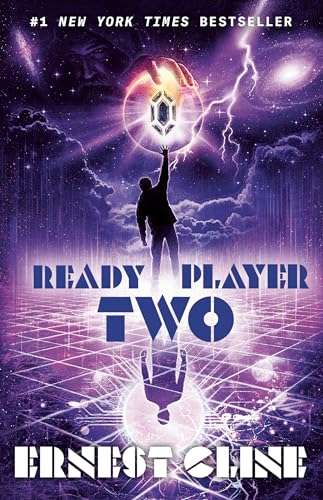
Book Review: Ready Player Two by Ernest Cline
Introduction
Ernest Cline’s Ready Player Two is the highly anticipated sequel to the bestselling dystopian science fiction novel Ready Player One. Picking up shortly after the events of the first book, Cline invites readers back into the intricate and evocative world of the OASIS, a virtual reality universe that serves as both a refuge and battleground for its users. This narrative not only continues the adventures of Wade Watts but also serves as a poignant commentary on modern society’s relationship with technology. In this sequel, the author examines the implications of rapidly evolving technology and its effects on society as a whole, delving into themes of nostalgia, identity, and the ethical dimensions of technological advancement. This review will explore the storyline, character dynamics, thematic elements, writing style, and offer a critical analysis of the book’s impact on both its genre and cultural relevance.
Plot Summary
Ready Player Two picks up where its predecessor left off, thrusting us back into the life of Wade Watts, who has recently become the champion of the OASIS after the untimely death of its creator, James Halliday. As Wade navigates his newfound fame and wealth, he stumbles upon a groundbreaking technology Halliday left behind—an OASIS Neural Interface that takes immersion in virtual reality to dizzying new heights. It promises to enhance users’ experiences, creating an almost indistinguishable line between reality and the virtual world.
This detail is significant because it establishes the central conflict of the novel: how far can technology go before it compromises human ethics and individuality? As Wade discovers the potential of this technology, he also becomes nuanced in understanding both its seductive allure and the potential for exploitation. The discovery sets the stage for a series of high-stakes challenges that not only threaten Wade and his friends but also highlight the broader societal concerns regarding technological advancement.
However, this newfound technology comes with a host of ethical dilemmas and stark moral implications. Wade realizes that such power could be weaponized or exploited, prompting internal reflections on what responsibility accompanies such abilities. Accompanied by his loyal friends—Art3mis, Aech, and Shoto—Wade embarks on yet another quest to uncover Halliday’s latest Easter egg, a journey that will test their friendship and resilience. This clearly draws from the classic quest narrative, yet Cline puts a modern spin on it by embedding deeper ethical considerations that readers are compelled to confront.
Cline’s narrative is rich with nostalgic references to 80s pop culture and gaming history. Each discovery serves not only as a nod to longtime fans but also as a means of exploring the dynamic nature of technology in contemporary society. How do these references anchor the characters? They provide a sense of familiar grounding amidst chaos, showcasing how past experiences shape present identities. The storyline pushes the boundaries of what is possible within the OASIS while also forcing characters—and readers—to confront the complexities of technological advancement and its ramifications.
Character Analysis
Wade Watts, the protagonist, displays notable character development throughout Ready Player Two. While he initially revels in his accomplishments and newfound status, Wade finds himself grappling with the responsibilities that accompany the title of OASIS champion. His introspective journey is marked by self-reflection as he navigates the emotional weight of his decisions, confronting issues of loyalty and the moral implications of his actions. This character arc resonates with readers, allowing them to witness Wade’s evolution from a passive gamer to an active participant in confronting real-world implications of escapism.
A compelling question arises: how does Wade’s transformation parallel real-life struggles against the backdrop of digital escapism? As we increasingly immerse ourselves in virtual realities, Wade’s journey remains relatable, underscoring a collective reckoning with the blend of virtual engagement and reality.
Art3mis, or Samantha Cook, is portrayed not only as Wade’s love interest but also as a strong, independent character in her own right. Her fierce determination and adeptness in navigating the virtual landscape are tested throughout the narrative, particularly as her relationship with Wade faces external pressures and internal conflicts. Cline successfully depicts the complexities of love in a digital age, emphasizing themes of trust and personal autonomy amidst the backdrop of a shared virtual existence.
This complexity raises the question: how does their relationship evolve against the pressures of a world shaped by technology? As both characters confront their insecurities, their dynamic ultimately reflects the challenges faced by many in the era of online interactions—struggles of authenticity, vulnerability, and connection.
Other characters like Aech and Shoto bring additional layers to the narrative, enriching the character dynamics through their unique perspectives. Aech’s humor and resourcefulness contrast with Shoto’s earnestness, both offering crucial insights into the evolving relationships among the group. This interplay highlights the importance of camaraderie and teamwork in the face of adversity, showcasing how each character’s strengths and weaknesses intertwine to shape their journey. New antagonists introduced in this sequel also highlight the potential dangers of unchecked technological power, challenging Wade and his friends as they navigate the treacherous waters of greed and ambition.
Thematic Exploration
Nostalgia is an enduring theme in Ready Player Two, permeating not only the characters’ motivations but also the very fabric of the OASIS itself. Cline examines the implications of living in a nostalgic haze versus addressing the pressing issues of the present. Characters often cling to familiar pop culture references as a way to anchor themselves in the chaos of their realities. But why is this reliance on nostalgia significant? Cline suggests that while it can provide comfort, it risks hindering personal growth and progression by encouraging avoidance of uncomfortable truths.
Identity is another central theme that Cline artfully navigates through the lens of the OASIS. Within this virtual space, characters explore various facets of themselves, experimenting with identities that differ from their real-world personas. However, this exploration prompts introspection about who they are beyond their online avatars, leading to existential questions about self-perception and authenticity. The distinction between virtual and real-life identities becomes increasingly blurred, compelling both characters and readers to ponder the nature of selfhood in the digital age.
Moreover, Cline adeptly addresses ethical dilemmas regarding technological advancement through the introduction of the OASIS Neural Interface. The narrative raises critical discussions about privacy, consent, and the consequences of merging reality with the virtual. By doing so, Cline provokes readers to engage in conversations about their own dependencies on technology, questioning whether we are losing sight of our true selves amidst the allure of digital existence. These themes resonate with contemporary societal concerns, urging readers to reflect on their relationships with technology and the potential hazards it harbors.
Historical Context
Published in an era when conversations about virtual reality, gaming culture, and digital identity are more relevant than ever, Ready Player Two reflects contemporary societal anxieties regarding technology and its implications. As immersive technologies gain traction and online communities reshape human interaction, the themes presented in Cline’s sequel resonate powerfully with readers living in a technology-saturated age. The nostalgic references to 80s culture serve a dual purpose: appealing to an audience that grew up with these influences while simultaneously introducing younger readers to this era’s lingering impact.
Cline’s exploration of nostalgia and identity draws parallels with current trends in entertainment, where remakes and revivals dominate cultural discourse. The dialogue surrounding nostalgia not only underlines the book’s relevance but also serves as a launching point for discussions about the implications of our affection for the past and its impact on our understanding of the present. In a landscape littered with digital distractions, what does it mean to engage with the past, and how can it inform our future?
Literary Devices
Cline employs several literary devices throughout Ready Player Two that enhance the reading experience. His descriptive language immerses readers in the vibrant and multifaceted environments of the OASIS, painting vivid pictures that invoke a palpable sense of wonder. The first-person narration creates intimacy, drawing readers close to Wade’s inner thoughts and emotional struggles, thus fostering a strong connection with the protagonist. How does this immersive style impact the reader’s engagement with Wade’s challenges? By inviting readers into Wade’s psyche, Cline allows them to experience his triumphs and tribulations firsthand, forging an emotional bond with the character.
Allusions to 80s movies, video games, and music not only serve as effective nostalgic touchstones but also function as narrative devices that enrich the overarching plot. These references act as a bridge between generations, facilitating discussions regarding cultural heritage and shared experiences. Cline effectively weaves humor along with pop culture references throughout his narrative, alleviating the gravity of serious moments and crafting a delicate balance between adventure and introspection. The brisk pacing of the narrative keeps readers engaged, delivering thrilling action sequences while still allowing for moments of reflection on the characters’ journeys.
By incorporating alternating perspectives, Cline offers a multifaceted view of the story, enhancing character depth and allowing for richer interactions. These literary strategies underscore the book’s themes and contribute to a more immersive reading experience.
Critical Evaluation
Ready Player Two has elicited a wide range of critiques, with varying reactions to its exploration of the original story’s themes. While many appreciate Cline’s ability to expand upon the universe established in Ready Player One, others argue that the heavy reliance on nostalgia and pop culture references can overshadow more profound character development and thematic exploration.
The pacing, while exhilarating, might overwhelm readers new to the complexity of the plot, particularly in how densely packed it is with references and action. This complexity can sometimes lead to a familiar rhythm rather than innovative storytelling. Yet, for fans of the first book, this reliance on nostalgia is often a cherished element that enhances their overall enjoyment of the sequel.
The ethical questions raised within the narrative regarding technology and its ramifications are especially pertinent, serving as a catalyst for broader discussions about virtual spaces and their implications on real-world interactions. Cline’s ability to embed these discussions into an engaging narrative demonstrates an acute awareness of contemporary issues while simultaneously maintaining the thrilling adventure that fans expect. Ultimately, the book urges readers to contemplate the implications of their digital lives, prompting critical reflections that extend beyond the page.
Conclusion
In conclusion, Ready Player Two emerges as a compelling sequel that builds upon the foundation established in Ready Player One, delving into a rich tapestry of themes that explore nostalgia, identity, and the ethical implications of technology. With multidimensional characters, an engaging plot, and thought-provoking themes, Cline has crafted a narrative that invites readers to reflect on their relationship with technology and the implications it carries. While the book may have its flaws, it undeniably resonates within the contemporary cultural landscape, offering a timely exploration of the nature of reality and the allure of virtual worlds. Both fans of the original and newcomers will find themselves captivated by this exhilarating journey that challenges us to consider the potential futures of technology and its impact on our lives.







Awesome https://is.gd/N1ikS2